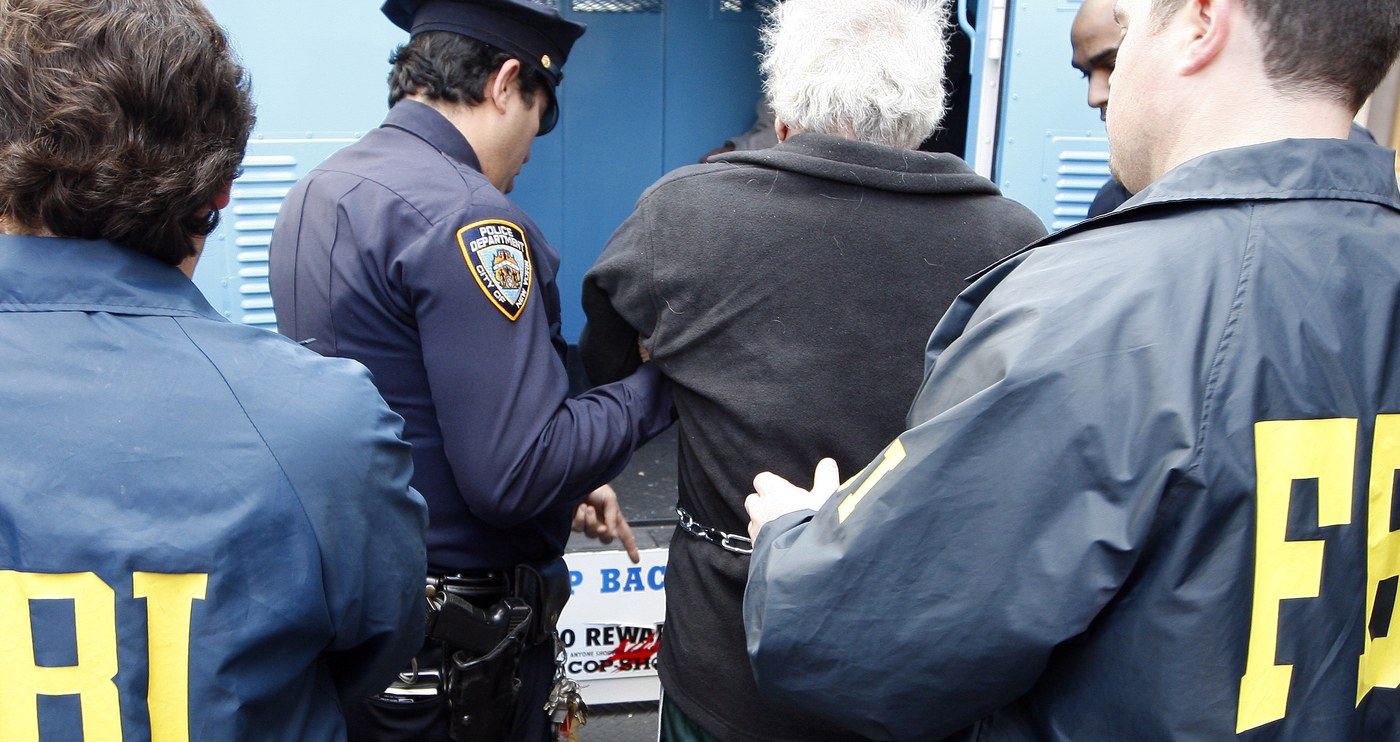FBI director outlines threats from transnational organized crime
Director Christopher Wray testifies before House committee on agency’s efforts to combat criminal networks around the world

Editor’s note: On February, 5, 2020, Christopher Wray, director of the Federal Bureau of Investigation, delivered a report to the House Judiciary Committee in Washington, D.C. The following excerpts from his report address the FBI’s observations and activities in combating transnational organized crime, including drug and human trafficking, cybercrime and money laundering. Wray also spoke about counterterrorism and counterintelligence matters.
Thank you for inviting me to appear before you today. I am honored to be here, representing the men and women of the FBI. Our people — nearly 37,000 of them — are the heart of the bureau. I am proud of their service and their commitment to our mission. Every day, they tackle their jobs with perseverance, professionalism and integrity.
In the past few years, I have had the chance to visit all 56 field offices. I have visited the home states of every member of this committee, talking with state and local law enforcement partners and people in your communities about the issues that matter most to them. I am grateful for their support and insights as we work together to keep 325 million American people safe and to help make our communities stronger.
Today’s FBI is a national security and law enforcement organization that uses, collects and shares intelligence in everything we do. Each FBI employee understands that, to defeat the key threats facing our nation, we must constantly strive to be more efficient and more effective. Just as our adversaries evolve, so, too, must the FBI. We live in a time of acute and persistent terrorist and criminal threats to our national security, our economy and, indeed, our communities. These diverse threats underscore the complexity and breadth of the FBI’s mission: to protect the American people and uphold the Constitution of the United States. …
Cyber threats
Virtually every national security threat and crime problem the FBI faces is cyber-based or facilitated. We face threats from state-sponsored hackers, hackers for hire, organized cyber syndicates and terrorists. On a daily basis, these actors seek to steal our state secrets, our trade secrets, our technology and the most intimate data about our citizens — things of incredible value to all of us and of great importance to the conduct of our government business and our national security. They seek to hold our critical infrastructure at risk, to harm our economy and to constrain our free speech.

As the committee is well aware, the frequency and severity of malicious cyber activity on our nation’s private sector and government networks have increased dramatically in the past decade when measured by the amount of corporate data stolen or deleted, the volume of personally identifiable information compromised or the remediation costs incurred by U.S. victims. We expect this trend to continue. Within the FBI, we are focused on the most dangerous malicious cyber activity: high-level intrusions by state-sponsored hackers, global organized crime syndicates and other technically sophisticated and dangerous actors. FBI agents, analysts and computer scientists are using technical capabilities and traditional investigative techniques —such as sources, court-authorized electronic surveillance, physical surveillance and forensics — to counter these threats. We continue to actively coordinate with our private and public sector partners to pierce the veil of anonymity surrounding cyber-based crimes.
Botnets used by cyber criminals have been responsible for billions of dollars in damages over the past several years. The widespread availability of malicious software (malware) that can create botnets allows individuals to leverage the combined bandwidth of thousands, if not millions, of compromised computers, servers or network-ready devices to disrupt the day-to-day activities of governments, businesses and individual Americans. Cyber-threat actors have also increasingly conducted ransomware attacks against U.S. systems, encrypting data and rendering systems unusable — thereby victimizing individuals, businesses and even emergency service and public health providers.
Cyber threats are not only increasing in size and scope, but are becoming increasingly difficult and resource-intensive to investigate. Cyber criminals often operate through online forums, selling illicit goods and services, including tools that lower the barrier to entry for aspiring criminals and that can be used to facilitate malicious cyber activity. These criminals have also increased the sophistication of their schemes, which are more difficult to detect and more resilient to disruption than ever. In addition, whether located at home or abroad, many cyber actors are obfuscating their identities and obscuring their activity by using combinations of leased and compromised infrastructure in domestic and foreign jurisdictions.
Such tactics make coordination with all of our partners, including international law enforcement partners, essential.
The FBI, in close cooperation with its federal partners, is engaged in myriad efforts to combat cyber threats, from improving threat identification and information sharing inside and outside of the government, to developing and retaining new talent, to examining the way we operate to disrupt and defeat these threats. We take all potential threats to public and private sector systems seriously and will continue to investigate and hold accountable those who pose a threat in cyberspace. …
Violent crime
Violent crimes and gang activities exact a high toll on individuals and communities. Many of today’s gangs are sophisticated and well organized and use violence to control neighborhoods, and boost their illegal money-making activities, which include robbery, drug and gun trafficking, fraud, extortion and prostitution rings. These gangs do not limit their illegal activities to single jurisdictions or communities. The FBI is able to work across such lines, which is vital to the fight against violent crime in big cities and small towns across the nation. Every day, FBI special agents work in partnership with federal, state, local and tribal officers and deputies on joint task forces and individual investigations.
FBI joint task forces — Violent Crime Safe Streets, Violent Gang Safe Streets and Safe Trails — focus on identifying and targeting major groups operating as criminal enterprises.
Much of the FBI criminal intelligence is derived from our state, local and tribal law enforcement partners, who know their communities inside and out. Joint task forces benefit from FBI surveillance assets, and our sources track these gangs to identify emerging trends. Through these multi-subject and multi-jurisdictional investigations, the FBI concentrates its efforts on high-level groups engaged in patterns of racketeering. This investigative model enables us to target senior gang leadership and to develop enterprise-based prosecutions.
By way of example, the FBI has dedicated tremendous resources to combat the threat of violence posed by MS-13. The atypical nature of this gang has required a multi-pronged approach — we work through our task forces here in the U.S. while simultaneously gathering intelligence and aiding our international law enforcement partners. We do this through the FBI’s Transnational Anti-Gang Task Forces (TAGs). Established in El Salvador in 2007 through the FBI’s National Gang Task Force, Legal Attaché San Salvador, and the U.S. Department of State, each TAG is a fully operational unit responsible for the investigation of MS-13 operating in the northern triangle of Central America and threatening the United States. This program combines the expertise, resources and jurisdiction of participating agencies involved in investigating and countering transnational criminal gang activity in the United States and Central America. There are now TAGs in El Salvador, Guatemala and Honduras. Through these combined efforts, the FBI has achieved substantial success in countering the MS-13 threat across the United States and Central America. …
Transnational organized crime and opioids
More than a decade ago, organized crime was characterized by hierarchical organizations, or families, that exerted influence over criminal activities in neighborhoods, cities or states. But organized crime has changed dramatically. Today, international criminal enterprises run multinational, multi-billion-dollar schemes from start to finish. Modern-day criminal enterprises are flat, fluid networks with global reach. While still engaged in many of the “traditional” organized crime activities of loan-sharking, extortion and murder, modern criminal enterprises are targeting stock market fraud and manipulation, cyber-facilitated bank fraud and embezzlement, drug trafficking, identity theft, human trafficking, money laundering, alien smuggling, public corruption, weapons trafficking, extortion, kidnapping and other illegal activities. Transnational organized crime networks exploit legitimate institutions for critical financial and business services that enable the storage or transfer of illicit proceeds. Preventing and combating transnational organized crime demands a concentrated effort by the FBI and federal, state, local, tribal and international partners.
While the FBI continues to share intelligence about criminal groups with our partners and combines resources and expertise to gain a full understanding of each group, the threat of transnational crime remains a significant and growing threat to national and international security with implications for public safety, public health, democratic institutions and economic stability across the globe.
Illicit drug trafficking continues to be a growing threat. Large amounts of high-quality, low-cost heroin and illicit fentanyl are contributing to record numbers of overdose deaths and life-threatening addictions nationwide. The accessibility and convenience of the drug trade online contributes to the opioid epidemic in the United States. Transnational criminal organizations are introducing synthetic opioids to the U.S. market, including fentanyl and fentanyl analogues. To address this evolving threat, we are taking a multifaceted approach and establishing many initiatives and units across our criminal program.
In January 2018, the Office of the Deputy Attorney General directed the FBI and other federal law enforcement partners to develop a strategic plan to disrupt and dismantle the Darknet illicit marketplaces facilitating the distribution of fentanyl and other opioids. As a result, the FBI established the Joint Criminal Opioid Darknet Enforcement (J-CODE) Initiative, which brings together agents, analysts and professional staff with expertise in drugs, gangs, health care fraud, and more, with federal, state and local law enforcement partners from across the U.S. government. The J-CODE team has developed a comprehensive, multi-pronged criminal enterprise strategy to target the trafficking of fentanyl and other opioids on the Darknet and Clearnet. This strategy focuses on identifying and infiltrating the marketplace administrative team, analyzing financial information, locating and exploiting marketplace infrastructure, targeting vendors and buyers, and enabling field office success in the investigation and prosecution of these marketplaces. As a result, numerous investigations and operations have been initiated and several online vendors who were facilitating the trafficking of opioids via the Internet have been disrupted.
The FBI is also addressing this threat through the Prescription Drug Initiative (PDI). The PDI was established in 2016 in response to the substantial and increasing threat associated with prescription drug diversion, and, in particular, the staggering national increase in opioid-related deaths. The objective of the PDI is to identify and target criminal enterprises and other groups engaged in prescription drug schemes; identify and prosecute, where appropriate, organizations with improper corporate policies related to prescription drugs; and identify and prosecute, where appropriate, organizations with improper prescribing and dispensing practices. The PDI prioritizes investigations that target “gatekeeper” positions, to include medical professionals and pharmacies that divert opioids outside the scope of their medical practice and/or distribute these medications with no legitimate medical purpose. Since its inception, the PDI has resulted in the conviction of numerous medical professionals and secured significant federal prison sentences, to include life terms for physicians who cause harm or death to the patients entrusted to their care.
Beyond these two programs, the FBI has dedicated additional resources to address this expansive threat. We have more than doubled the number of Transnational Organized Crime Task Forces, expanded the Organized Crime Drug Enforcement Task Force Airport Initiative to focus on insider threats partnering with TCO actors, and created and led the Fentanyl Safety Working Group at FBI Headquarters, which has led to a new program to protect field agents and support employees with personal protective equipment and opioid antagonists (i.e., naloxone) from the threat of fentanyl exposure. The FBI participated, along with other federal partners, in the creation of the Heroin Availability Reduction Plan (HARP), takes part in monthly HARP implementation meetings hosted by the Office of National Drug Control Policy, and continues to provide training to our international law enforcement partners on successful identification, seizure and neutralization of clandestine heroin/fentanyl laboratories.
Crimes against children and human trafficking
It is unthinkable, but every year, thousands of children become victims of crimes — whether it is through kidnappings, violent attacks, sexual abuse, human trafficking or online predators. The FBI is uniquely positioned to provide a rapid, proactive and comprehensive response; identify, locate and recover child victims; and strengthen relationships between the FBI and federal, state, local, tribal and international law enforcement partners to identify, prioritize, investigate and deter individuals and criminal networks from exploiting children.

But the FBI’s ability to learn about and investigate child sexual exploitation is being threatened by the spread of lawless spaces online. For example, currently, there are at least 30 child pornography sites operating openly and notoriously on the Darknet, including the Tor network. Some of these child pornography sites are exclusively dedicated to the sexual abuse of infants and toddlers. The sites often expand rapidly, with one site obtaining 200,000 new members within its first four weeks of operation.
As was highlighted at a summit held at the Department of Justice on October 4 that focused on warrant-proof encryption and its impact on child exploitation cases, law enforcement stands to lose millions of leads a year due to the adoption of end-to-end encryption. This move will stop technology and social media companies from being able to detect and report child sexual abuse material being traded on their platforms. The spread of end-to-end encryption will not just dry up the leads, it will prevent companies from providing content to law enforcement in response to legal process — the content we need to actually find who and where a victim is. Unfettered online spaces beyond the protection of law allow dangerous criminals to abuse and exploit an untold number of children. By enabling dangerous criminals to cloak their communications and activities behind an essentially impenetrable digital shield, the deployment of warrant-proof encryption is already imposing huge costs on society. It is not just the reprehensible behavior of sexual predation on children, but myriad additional forms of serious crime enabled by end-to-end encryption. This technology is quickly extinguishing our ability to detect and prevent a wide range of criminal activity — from terrorism to large-scale drug trafficking, to financial fraud, to human trafficking, to transnational gang activity. We realize this is a difficult and complex challenge. However, while we continue to embrace the use of strong encryption within our most critical sectors and infrastructure, we must seek a solution that allows us to protect our nation’s most vulnerable while at the same time addressing the equities of the larger national security community.
The FBI has several programs in place to arrest child predators and to recover missing and endangered children. To this end, the FBI funds or participates in a variety of endeavors, including our Innocence Lost National Initiative, Innocent Images National Initiative, Operation Independence Day, Child Abduction Rapid Deployment Teams, Victim Services, 80 Child Exploitation Task Forces, 53 International Violent Crimes Against Children Task Force Officers, as well as numerous community outreach programs to educate parents and children about safety measures they can follow.
The FBI combats this pernicious crime problem through investigations such as Operation Pacifier, which targeted the administrators and users of a highly sophisticated, Tor-based global enterprise dedicated to the sexual exploitation of children. This multi-year operation has led to the arrest of over 348 individuals based in the United States, the prosecution of 25 American child pornography producers and 51 American hands-on abusers, the rescue or identification of 55 American children, the arrest of 548 international individuals and the identification or rescue of 296 children abroad.
Child Abduction Rapid Deployment Teams are ready response teams stationed across the country to quickly respond to abductions. Investigators bring to this issue the full array of forensic tools such as DNA analysis, trace evidence, impression evidence and digital forensics. Through improved communications, law enforcement also has the ability to quickly share information with partners throughout the world, and these outreach programs play an integral role in prevention.
In addition to programs to combat child exploitation, the FBI also focuses efforts to stop human trafficking — a modern form of slavery. The majority of human trafficking victims recovered during FBI investigations are U.S. citizens, but traffickers are opportunists who will exploit any victim with a vulnerability. Victims of human trafficking are subjected to forced labor or sex trafficking, and the FBI is working hard with its partners to combat both forms.
The FBI works collaboratively with law enforcement partners to investigate and arrest human traffickers through Human Trafficking Task Forces nationwide. We take a victim-centered, trauma-informed approach to investigating these cases, and strive to ensure the needs of victims are fully addressed at all stages. To accomplish this, the FBI works in conjunction with other law enforcement agencies and victim specialists on the local, state, tribal and federal levels, as well as with a variety of vetted non-governmental organizations. Even after the arrest and conviction of human traffickers, the FBI often continues to work with partner agencies and organizations to assist victims in moving beyond their exploitation.
Earlier this year, the FBI announced the results of Operation Independence Day, which relied on more than 400 law enforcement agencies working on FBI Child Exploitation and Human Trafficking Task Forces in each of the bureau’s 56 field offices. Agents and analysts at FBI Headquarters and in the field worked closely with the National Center for Missing & Exploited Children to identify young runaways, missing kids and juveniles who may have been subjected to human trafficking. The sweep included undercover operations and has led to the opening of 60 new federal criminal investigations. In all, 103 juveniles were identified or recovered and 67 suspected traffickers were arrested.
The FBI commends the committee’s dedication to these efforts and appreciates the resources provided to combat these horrific acts. …
Christopher Wray has been the FBI director since 2017.
Feedback or questions? Email blog@themobmuseum.org





